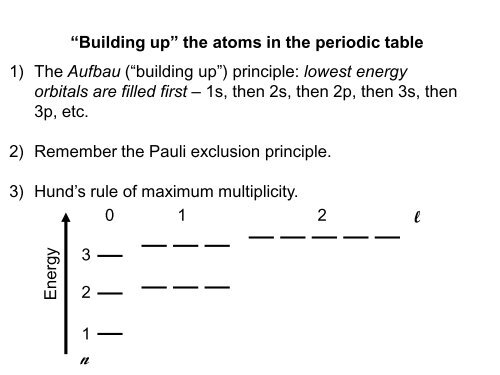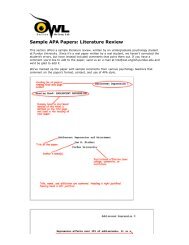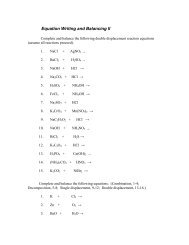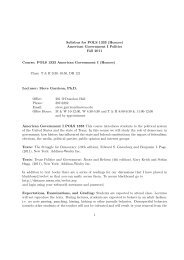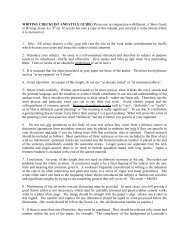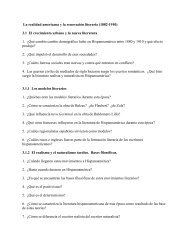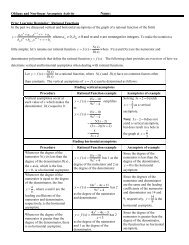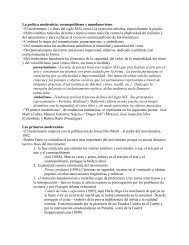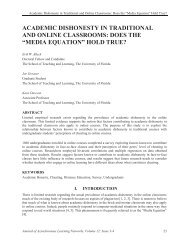Lecture 4
Lecture 4
Lecture 4
Create successful ePaper yourself
Turn your PDF publications into a flip-book with our unique Google optimized e-Paper software.
“Building up” the atoms in the periodic table<br />
1) The Aufbau (“building up”) principle: lowest energy<br />
orbitals are filled first – 1s, then 2s, then 2p, then 3s, then<br />
3p, etc.<br />
2) Remember the Pauli exclusion principle.<br />
3) Hund’s rule of maximum multiplicity.<br />
Energy<br />
3<br />
2<br />
1<br />
n<br />
0 1 2<br />
l
Hund’s rule of maximum multiplicity<br />
“Multiplicity” is a measure of the number of unpaired electrons.<br />
Multiplicity = number of unpaired electrons + 1<br />
# of unpaired<br />
electrons<br />
Multiplicity Common Name<br />
0 1 singlet<br />
1 2 doublet<br />
2 3 triplet<br />
3 4 quartet<br />
Hund’s rule: Electrons must be placed in the orbitals of a<br />
subshell so as to give the maximum total spin.<br />
i.e. put as many unpaired electrons as possible in a subshell to<br />
get the most stable arrangement.
The theory underlying Hund’s rule of maximum multiplicity<br />
1. Minimization of electron-electron repulsion<br />
- There is less repulsion between electrons in different<br />
orbitals (different regions in space)<br />
Electrons in different orbitals feel a greater Z*, thus they are more stable
The theory underlying Hund’s rule of maximum multiplicity<br />
2. Maximization of exchange energy stabilization<br />
- This is a quantum mechanical effect that causes<br />
systems with electrons of the same energy and spin to<br />
be more stable.<br />
- The more exchanges possible, the more stable the<br />
electron configuration of the subshell<br />
For an s-orbital (subshell), the spins must be different, so<br />
no exchanges are possible
For a p subshell, there are different orbitals of the same energy<br />
and exchanges are possible.<br />
Two electrons of opposite spin, no exchange is possible:<br />
Two electrons of the same spin, one exchange is possible:<br />
Initial arrangement<br />
One exchange
Three electrons of same spin, three exchanges are possible:<br />
Initial arrangement<br />
One exchange<br />
Second exchange<br />
Third exchange<br />
The exchange energy explains why half-filled subshells are<br />
unusually stable.<br />
e.g. the electron configuration of Cr: [Ar]4s 1 3d 5 instead of<br />
[Ar]4s 2 3d 4
Energy<br />
Building up the atoms in the periodic table:<br />
Period One<br />
Z Atom Electron<br />
configuration<br />
para- or<br />
diamagnetic<br />
∆H ie<br />
(first / eV)<br />
1 H 1s 1 p 13.6<br />
2 He 1s 2 d 24.6<br />
3<br />
2<br />
1<br />
n<br />
0 1 2<br />
l
Energy<br />
Building up the atoms in the periodic table:<br />
Period Two<br />
Z Atom Electron<br />
configuration<br />
para- or<br />
diamagnetic<br />
∆H ie<br />
(first / eV)<br />
3 Li [He]2s 1 p 5.4<br />
4 Be [He]2s 2 d 9.3<br />
3<br />
2<br />
1<br />
n<br />
0 1 2<br />
l
Orbital energy levels and atomic number<br />
For atoms other than hydrogen:<br />
Orbital energy depends on n and l<br />
Ordering of orbital energies:<br />
ns < np < nd < nf<br />
Remember:<br />
This ordering is due to the<br />
different penetrating ability of the<br />
different types of orbitals and the<br />
different effective nuclear charges<br />
felt by the electrons in those<br />
orbitals.
Building up the atoms in the periodic table:<br />
Period Two<br />
Z Atom Electron<br />
configuration<br />
para- or<br />
diamagnetic<br />
∆H ie<br />
(first / eV)<br />
5 B [He]2s 2 2p 1 p 8.3<br />
6 C [He]2s 2 2p 2 p 11.3<br />
7 N [He]2s 2 2p 3 p 14.5<br />
8 O [He]2s 2 2p 4 p 13.6<br />
9 F [He]2s 2 2p 5 p 17.4<br />
10 Ne [He]2s 2 2p 6 d 21.6<br />
Energy<br />
0 1 2 l<br />
3<br />
2<br />
1<br />
n
The ∆H ie anomaly at nitrogen and oxygen C<br />
Π c = Coulombic energy<br />
(destabilizing)<br />
Hypothetical arrangement<br />
Π e = exchange energy<br />
(stabilizing)<br />
1 Π e<br />
N<br />
3 Π e<br />
O<br />
1 Π c + 3 Π e
Energy<br />
Building up the atoms in the periodic table:<br />
Period Three<br />
Z Atom Electron<br />
configuration<br />
para- or<br />
diamagnetic<br />
∆H ie<br />
(first / eV)<br />
11 Na [Ne]3s 1 p 5.1<br />
12 Mg [Ne]3s 2 d 7.6<br />
3<br />
2<br />
1<br />
n<br />
0 1 2<br />
l
Building up the atoms in the periodic table:<br />
Period Three<br />
Z Atom Electron<br />
configuration<br />
para- or<br />
diamagnetic<br />
∆H ie<br />
(first / eV)<br />
13 Al [Ne]3s 2 3p 1 p 6.0<br />
14 Si [Ne]3s 2 3p 2 p 8.2<br />
15 P [Ne]3s 2 3p 3 p 10.5<br />
16 S [Ne]3s 2 3p 4 p 10.4<br />
17 Cl [Ne]3s 2 3p 5 p 13.0<br />
18 Ar [Ne]3s 2 3p 6 d 15.8<br />
Energy<br />
0 1 2 l<br />
3<br />
2<br />
1<br />
n
Energy<br />
Building up the atoms in the periodic table:<br />
Period Four<br />
Z Atom Electron<br />
configuration<br />
para- or<br />
diamagnetic<br />
∆H ie<br />
(first / eV)<br />
19 K [Ar]4s 1 p 4.3<br />
20 Ca [Ar]4s 2 d 6.1<br />
4<br />
3<br />
2<br />
1<br />
n<br />
0 1 2<br />
l
An anomaly of the periodic table<br />
The 4s orbitals are lower in energy than the<br />
3d orbitals for K and Ca.<br />
This is only for the free atoms! In<br />
molecules 3d are lower in energy than 4s!<br />
This is assumed to be an accident of nature<br />
but it is consistent throughout the table.
Building up the atoms in the periodic table:<br />
Period Four<br />
Z Atom Electron<br />
configuration<br />
para- or<br />
diamagnetic<br />
∆H ie<br />
(first / eV)<br />
21 Sc [Ar]4s 2 3d 1 p 6.5<br />
22 Ti [Ar]4s 2 3d 2 p 6.8<br />
23 V [Ar]4s 2 3d 3 p 6.7<br />
24 Cr [Ar]4s 1 3d 5 p 6.8<br />
25 Mn [Ar]4s 2 3d 5 p 7.4<br />
26 Fe [Ar]4s 2 3d 6 p 7.9<br />
27 Co [Ar]4s 2 3d 7 p 7.9<br />
28 Ni [Ar]4s 2 3d 8 p 7.6<br />
29 Cu [Ar]4s 1 3d 10 p 7.7<br />
30 Zn [Ar]4s 2 3d 10 d 9.4
Building up the atoms in the periodic table:<br />
Period Four<br />
Z Atom Electron<br />
configuration<br />
para- or<br />
diamagnetic<br />
∆H ie<br />
(first / eV)<br />
31 Ga [Ar]4s 2 3d 10 4p 1 p 6.0<br />
32 Ge [Ar]4s 2 3d 10 4p 2 p 7.9<br />
33 As [Ar]4s 2 3d 10 4p 3 p 9.8<br />
34 Se [Ar]4s 2 3d 10 4p 4 p 9.7<br />
35 Br [Ar]4s 2 3d 10 4p 5 p 11.8<br />
36 Kr [Ar]4s 2 3d 10 4p 6 d 14.0<br />
Energy<br />
0 1 2 l<br />
4<br />
3<br />
2<br />
1<br />
n
Building up the atoms in the periodic table:<br />
Period Five:<br />
- analogous to Period Four<br />
Period Six:<br />
- analogous to Period Five with the introduction of the (4f)<br />
Lanthanides after the 6s elements<br />
Period Seven:<br />
- in theory, analogous to Period Six with the introduction of the<br />
Actinides (5f) after the 7s elements but little is known about<br />
the short-lived nuclei after Z=104 (Rutherfordium).
Trends for Atomic Properties in the Periodic Table<br />
Understanding how and why properties change from<br />
element to element requires us to consider:<br />
1. The electron configuration of<br />
the atom or ion (the filling<br />
order)<br />
2. The type of valence orbitals<br />
involved (size, shape,<br />
shielding and penetration)<br />
3. The effective nuclear charge<br />
felt by electrons in valence<br />
orbitals<br />
4. “Oddities”
increases<br />
The Size of Atoms and Ions<br />
Radii of neutral atoms<br />
The atomic radius of an atom is defined as half the distance between the<br />
nuclei in a homonuclear bond.<br />
r decreases<br />
In general:<br />
- radii decrease across a period<br />
because of increasing Z*.<br />
-radii increase down a group<br />
because of the increasing<br />
distance of the electrons from<br />
the nucleus.<br />
- increasing distance from the<br />
nucleus outweighs effective<br />
nuclear charge for atomic radii<br />
down a group.
Remember that the maximum probability for an orbital moves<br />
further away from the nucleus with increasing n.<br />
0.1 nm = 1 Å = 100 pm<br />
Bohr model for H; radius(n) = n 2 a 0<br />
The “d-block contraction” causes<br />
Ga to be about the same size as Al.<br />
This is caused by the introduction of<br />
the 3d elements which cause a<br />
vastly larger Z* for Ga.
Radii of ions<br />
This is a “self-consistent” scale based<br />
on O -2 = 1.40 (or 1.38) Å.<br />
Ionic radii depend on the magnitude<br />
of the charge of the ion and its<br />
environment. (more later)<br />
Positively charged ions are smaller<br />
than their neutral analogues because<br />
of increased Z*.<br />
Negatively charged ions are larger<br />
than their neutral analogues because<br />
of decreased Z*.<br />
Same periodic trends as atomic<br />
radii for a given charge
The utility of covalent and ionic radii<br />
The radii tabulated in various books allow us to predict the bond length<br />
(distance between nuclei) we would expect to see for a new bond.<br />
Example:<br />
What is the expected bond length for a single Sb-N bond ?<br />
For N, r cov = 0.70 Å and for Sb, r cov = 1.41 Å<br />
Using these values, an Sb-N bond should be 2.11 Å.<br />
The experimental distance is 2.05 Å.<br />
For covalent radii, the predictions will be the best for atoms<br />
that have similar electronegativities. If the electronegativities<br />
are very different, the predicted distance will be too long.
van der Waals radii are established from contact distances between nonbonding<br />
atoms in “touching” molecules or atoms<br />
VDW radii allow us to<br />
determine whether there<br />
can be a bonding<br />
interaction between two<br />
atoms:<br />
If the distance between<br />
the nuclei is larger than<br />
the sum of the VDW radii,<br />
then the atoms are<br />
probability not bonded.<br />
van der Waals radii<br />
r VDW increases<br />
r VDW decreases
Ionization Enthalpy, ∆H ie (ionization potential)<br />
The enthalpy change for ionization by loss of electron(s)<br />
E (g) → E + (g) + e - ∆H ie “First ionization potential”<br />
E + (g) → E 2+ (g) + e - ∆H ie “Second ionization potential” > first<br />
E 2+ (g) → E 3+ (g) + e - ∆H ie “Third ionization potential” > second<br />
… …<br />
∆H ie decreases<br />
∆H ie increases
Features and anomalies in the trend of first ionization energies<br />
→ B: [He]2s 2 2p 1 – p<br />
orbitals are more effectively<br />
sheilded than s orbitals so<br />
smaller Z* and lower ∆H ie.<br />
(also [He]2s 2 is a full<br />
subshell)<br />
→ O: [He]2s 2 2p 4 – first<br />
pairing of electrons causes<br />
repulsion so loss of one<br />
electron is more favourable.<br />
→ Na: [Ne]3s 1 – expected<br />
from lower Z* and greater<br />
distance of the electron<br />
from the nucleus at the start<br />
of a new shell.
Features and anomalies in the trend of first ionization enthalpies<br />
Group 17 is “normal” – ∆H ie decreases<br />
down the group as one would expect<br />
based on the increasing distance of the<br />
electrons from the nucleus.<br />
Group 13 has unusual features – ∆H ie<br />
does not decrease down the group (and<br />
is higher for Tl than for Al, Ga or In.<br />
∆H ie is greater than expected for Ga<br />
because of the greater Z* caused by the<br />
presence of the 3d elements.<br />
∆H ie is greater than expected for Tl<br />
because of the “greater Z*” caused by<br />
relativistic effects.
The trends are “shifted” for higher ionization enthalpies<br />
Just consider the new electron configurations of the ions and the same<br />
arguments apply. The one new feature is the very high ∆H ie for early groups.<br />
Ca: [Ne]3s 2 3p 6 4s 2 → Ca + : [Ne]3s 2 3p 6 4s 1 ∆H ie = 6.1 eV<br />
Ca + : [Ne]3s 2 3p 6 4s 1 → Ca 2+ : [Ne]3s 2 3p 6 ∆H ie = 11.9 eV<br />
Ca 2+ : [Ne]3s 2 3p 6 → Ca 3+ : [Ne]3s 2 3p 5 ∆H ie = 50.9 eV<br />
- core electrons are much more stable and require much more energy to<br />
remove


